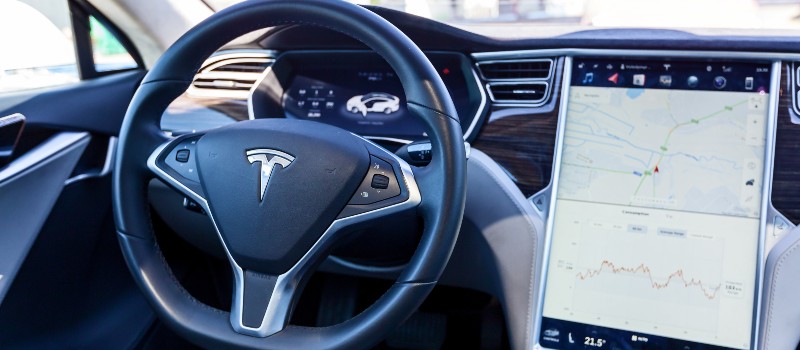
Silent means deadly – why noise matters for electric cars
23rd Aug, 2021
The electric car revolution is steadily powering up, with close to half a million already active in the UK. There’s certainly a lot of advantages to be gained by electrifying the cars we drive as a nation; for starters, it will help us achieve a drastic reduction in the level of emissions we produce (a major priority for the government right now). So if you end up thinking ‘I need to scrap my car’ at some point in the next few years, you might find yourself more than tempted by an electric alternative.
However, although there are clear benefits to widespread adoption, electric cars aren’t quite perfect. In fact, while they solve several longstanding issues with our personal transport system, they also introduce a few new ones. One of the most pressing might surprise you – it’s all to do with the sound they make. Or rather, the sounds they don’t.
Why nobody wants the sound of silence
Let’s start with the obvious. Most of us are so used to the sound of internal combustion engines that it’s easy to forget just how loud they are. In fact, you might be surprised at how quiet cars can be without them. Without the characteristic rumbling and roaring of a combustion engine, the only sound that electric cars make tends to come from the contact of their tyres on the road, or the wind rushing over their bodywork. Even those are both sounds that are generally only audible at higher speeds.
You don’t need to be a road safety engineer to see why this near-silence might be so dangerous to surrounding road users, especially in built-up areas like narrow residential streets or built-up city centres. In fact, one study indicates that people are 40% more likely to be hit by an electric car or hybrid car, since they won’t be able to hear it coming. Hybrid cars are already pretty widespread, so if you’ve ever had a close shave with one of those yourself, you’ll know exactly what we’re talking about!
While this poses a tangible risk to all vulnerable road users, it’s especially dangerous for disabled people, such as blind or partially-sighted people. One particular study indicated that 93% of visually impaired respondents experienced problems with detecting and avoiding electric cars in simulated traffic.
According to UK charity Guide Dogs for the Blind, a big part of this difficulty lies in the fact that visually impaired people aren’t listening for individual vehicles, but what they call traffic’s “wall of sound”. They wait for a break in this wall to know when it’s safe to cross the road. But if the traffic itself doesn’t make a noise, it’s much more difficult for them to accurately judge when it’s safe to attempt to do so.

It’s also worth highlighting some supporting research from the University of California, which concluded that some electric and hybrid cars can’t be heard until one second before impact. Unless you have superhuman reflexes, that’s nowhere near enough time to get out of the way.
In the coming years, electric vehicles are going to become an ever more prevalent presence on British roads. By 2030, when the petrol and diesel ban is due to come into full force, the National Grid thinks that there could be as many as 9 million electric vehicles on our roads. So how can we keep more vulnerable road users safe?
Electric cars now legally required to make noise
The issues with quietness in electric cars have been very well-known for quite some time now, so the European Union has already taken steps to address the problem. At the crux of its response was a new law called the Regulation on the Sound Level of Motor Vehicles, which it introduced on the 1st of July 2019. (The name might lack a certain pizzazz, but there’s no denying that it does what it says on the tin.)
The Regulation makes it a legal requirement for all new electric vehicles to be fitted with an Acoustic Vehicle Alert System (AVAS), which must a clearly audible sound of at least 56 decibels (dB) of noise at speeds of up to 12.4mph. This applies both to driving forwards, and accelerating. And in case you’re wondering, no, a car’s ACAS cannot be switched off by its driver.
This regulation has now been in force for over two years, but long before the start date, a number of car manufacturers were already implementing their own versions of an AVAS in their brand new vehicles, including Mitsubishi, Nissan and Toyota.
Most recently, more manufacturers have been further developing their individual approaches by tailoring their alerts to different circumstances. The Vauxhall Corsa-e, for example, makes an external noise that’s loudest at 12mph, but remains active until the car exceeds 25mph. That’s largely because Vauxhall recognised that although the noise would provide maximum safety value at lower speeds, it would still be useful for alerting pedestrians and other road users while the car was travelling in confined town centres or city sprawls, too.

Now, right now most of these systems are reactive, which means they make sounds according to the situations developing around them. (For example, a car might emit a low noise when it detects a slow-moving cyclist approaching from some distance away, while it might emit an ear-splitting alarm if a pedestrian unwittingly steps out only metres out in front of it.)
But some critics have voiced concerns about the limits of this sort of setup, as it works best with relatively simple encounters when there’s only one car and one pedestrian. Instead, when you’ve got a more complex situation with multiple cars and other road users involved, some observers suggest that these audible signals should work more like indicators and brake lights – communicating a driver’s intentions before they happen, rather than trying to use machine intelligence to react to a changing situation on the fly.
As electric cars become even more widespread in years to come, it remains to be seen whether manufacturers or lawmakers will adopt this alternative approach. For now, at least cyclists and pedestrians can rest assured that AVAS systems will continue to protect them in some form; from 2021, car manufacturers are mandated to include them in all new electric cars, not just their brand new models.
What sound will electric cars actually make?
To be honest, the answer hasn’t quite been finalised yet. Again, lots of manufacturers seem to be adopting their own. Over in the US, the Chevrolet Volt makes a sound like a creaky door to warn nearby vulnerable road users, whereas the Toyota RAV4 makes an ‘incessant beep’ noise for the same purpose. The Toyota Prius, on the other hand, deploys a frankly unnerving low harmonic hum.
But while manufacturers have been experimenting with various options, the EU is already nailing down its requirements for these noises. It says the sound must be continuous and progressive, and must clearly be that of a car, so that people instantly know what to look for. On the other side of the world, Japan is setting similar restrictions, having specified that electric cars aren’t allowed to make sounds like animals or any other natural phenomenon.
All this makes sense when you think about it – after all, it’s a safety system, not a novelty feature or marketing tool. Notably, Jaguar tried implementing a noise that sounded like a sci-fi spaceship, but unfortunately it ended up making pedestrians look skywards, and away from the road – definitely not a desirable result!
The United Nations is already employing its own experts in this field, one of whom recommends that these alerts be a standard mix of tonal sounds and white noise. The advantages of white noise lend themselves particularly well to these sorts of safety features. First of all, white noise is pleasant and non-stressful, like the sound of falling water. Secondly, it gives the listener a clear sense of direction, enabling them to easily identify where the noise is coming from – which could make all the difference to their safety in an emergency scenario.

The demand for internal engine noise
All this is still relatively early days of course, and for their own AVAS systems many manufacturers have simply opted for noises that sound like an electric engine – but of course, one that’s been amplified several times over. Lots of big name manufacturers are also working on giving drivers control over making AVAS audible inside the cabin, too.
That’s partially a practicality issue, to reassure drivers that the safety system is indeed functional, and that people outside the car can hear them coming. But it’s also partially a comfort issue too. Whether conscious of it or not, most drivers rely on audio cues from the engine for subtle feedback on their driving at any given moment. Engine noise can communicate how hard a car is working, how fast it’s moving, and whether anything is wrong – so when all that’s replaced with empty silence, it can leave drivers understandably uncertain.
So, manufacturers have been working on their own solutions to produce artificial engine sounds for drivers of their electric cars. BMW uses its ‘Active Sound Design’ system, Ford has its similarly-named Active Noise Control system, and Volkswagen has connected its Golf R’s Soundaktor system to a speaker in the cabin.
But will the demand for internal engine noise fade in time, as drivers get used to the idea of quieter engines? And how will AVAS systems develop in future, in line with shifting infrastructure and gradually shifting cultural attitudes? We won’t pretend to have the answers here at Scrap Car Network – when it comes right down to it, only time will tell!
We’ll tell you what, though. Whatever happens with the electric vehicle industry, you can always rely on us right here at Scrap Car Network to help you scrap your car for the best price. We make it fast and easy to scrap your car for cash – just enter your car reg and postcode into our website for an instant, no obligation valuation! Curious to find out how much your old car is worth?